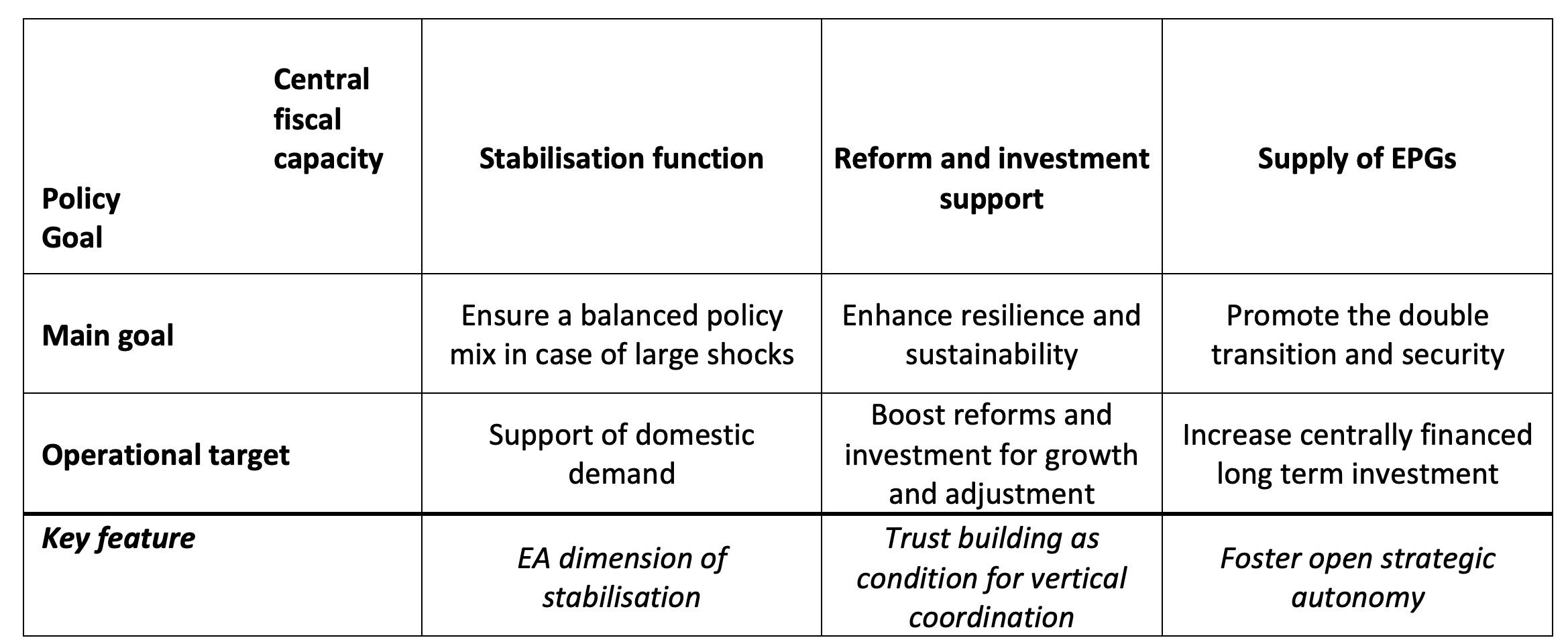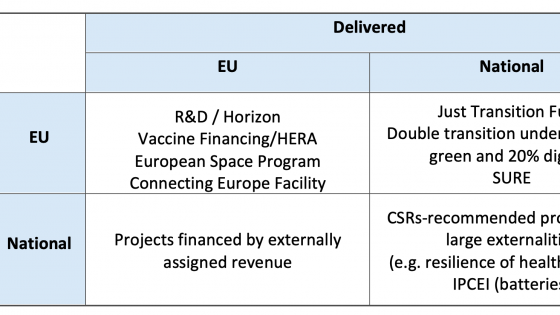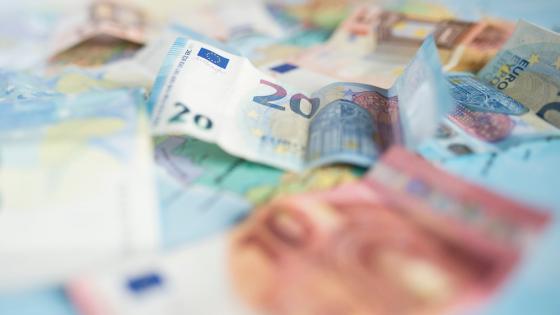Editors' note: This column is a lead commentary in the VoxEU debate on euro area reform.
NextGenerationEU (NGEU) is the centralised fiscal initiative agreed by the EU in 2020 to ‘build back better’ after the pandemic; and the ‘Fit-for-55’ indicates the road that the EU should follow to reach the sustainable economic and social development that is one of the main aims of a central fiscal capacity. The EU’s long-term economic potential would be improved if the member states were able to effectively meet the NGEU and Fit-for-55 requirements, also through the most recent REPowerEU recommendations.
In the past year, several academic papers have called for the setting up of a permanent central fiscal capacity at the EU or euro area level (e.g. Beetsma et al. 2021, Maduro et al. 2021, Romanelli et al. 2022). During the public consultation on the review of the EU economic governance by the Commission, the ECB, IMF and OECD made similar proposals. In a previous paper (Buti and Messori 2021), we outlined that – in principle – a central fiscal capacity could focus on three functions: cyclical stabilisation, support for the implementation of national structural reforms and investment, and the supply of European public goods (EPGs). Table 1 sketches out the main goals, the operational targets, and the key features of these three options.
Table 1 Central fiscal capacity: Three options
Source: authors’ elaborations
Creating a central stabilisation capacity would be the most rational choice for the completion of the euro area’s economic governance framework. It would complement the response of the ECB and of national fiscal policies to symmetric and country-specific demand shocks. The most cumbersome political issue is moral hazard: if the national governments anticipated the support by a central fiscal instrument in case of negative shocks, they would have less incentive to create national fiscal room for manoeuvre in periods of strong growth. This would lead to a ratcheting up of public debt and would increase the risk of that form of fiscal dominance that characterised the euro area in the period 2014–2018. The observed lack of fiscal adjustments during ‘good times’ strengthened this argument (e.g. European Commission, 2019). Hence, the political feasibility of the first option will remain untested unless there is a significant improvement in cooperation (and trust) between the EU’s member states.
The second option – that is, setting up conditional transfers to the EU member states to support national reforms and investment – would build on NGEU arrangements and be akin to de facto reviving the proposal of ‘contractual arrangements’ made by Herman van Rompuy in mid-2013 when he was at the helm of the European Council. The proposal was rejected by the majority of the EU’s member states at the end of that same year: the Northern countries refused permanent transfers, whilst the Southern countries resented an intrusive role of the European authorities in their domestic policy choices. Under the pressure of the pandemic shock, NGEU overcame those objections by its temporary nature.
A third option is to use the central fiscal capacity to step up the supply of EPGs. Whilst NGEU represented a breakthrough and a fundamental institutional innovation, its ‘European added value’ in its final design was lower than in the initial proposal by the Commission. As we pointed out in an earlier paper (Buti and Messori 2020, see also Pisani Ferry 2020), in the agreement on NGEU reached at the European Council in July 2020, the non-allocated part of its main programme (the Recovery and Resilience Facility, or RRF) was substantially reduced in favour of transfers to member states. Conversely, the supply of ‘pure’ European public goods (as dubbed by Buti and Papaconstantinou 2022) – such as a European security system, the joint public procurement of vaccines, investment in hydrogen energy, the construction of a European telecommunication network, or the joint production of semiconductors – cannot be satisfied by the simple aggregation of national public goods.
A central fiscal capacity in the response to shocks
The three options for a central fiscal capacity have different implications in the response to shocks. In a recent paper (Buti and Messori 2022), we analyse how a central fiscal capacity could help achieve policy efficiency, that is, selecting the policy mix with the lowest costs in terms of changes in monetary policy and national fiscal policies. We build a stylised aggregate demand–aggregate supply model where the size of a central fiscal capacity depends on the intensity of shocks and the degree of compliance with common fiscal rules. We show that a central fiscal capacity helps rebalance the combination of the common monetary policy and national fiscal policies in absence of shocks. Instead, in response to shocks, the central fiscal capacity’s benefits depend on the typology of shocks as well as on the specific option chosen among the three illustrated in Table 1. Under negative demand shocks, a central fiscal stabilisation capacity improves policy efficiency by reducing the pressure on national fiscal policies – hence favouring compliance with the common fiscal rules – and helping monetary policy to escape the zero lower bound (ZLB)/effective lower bound (ELB). Under negative supply shocks, policy efficiency is instead improved by a central fiscal capacity focusing on supporting reform and investment or delivering 'pure' public goods. By boosting potential output, these two options of central fiscal capacity help stem the need for monetary restrictions and hence lessen the trade-off between growth and inflation. We argue in our paper that, between the option of supporting national reforms and supplying 'pure' public goods, the latter is likely to be more effective due to its direct impact on potential output.
Our analysis helps assess the efficiency of the EU’s response to the pandemic. The introduction of NGEU as a temporary fiscal tool contributed to achieving a more effective response to the Covid crisis compared to the response to the global financial crisis and the euro area crisis. To help monetary policy escape the ELB, fiscal policy had to become expansionary. However, if only national fiscal policy had been available, the appropriate national fiscal stance would have required a stronger boost and hence an even larger violation of the rules of the Stability and Growth Pact. This national fiscal stance would have also increased the pressure on the ECB, thereby accentuating the risk of fiscal dominance in the EU.
Addressing stagflation
The EU policy response to the stagflationary shock brought about by the legacy of the pandemic and Russia’s invasion of Ukraine is still in the making. The steep rise in the inflation rate has led the ECB to discontinue its unconventional net purchases of assets, to reduce its amount of refinancing, and to move out of negative policy interest rates. Moreover, the ECB has announced additional rises in its policy interest rates in the next months. At the same time, it is recognised that the bourgeoning public debt needs to be put under control, particularly in the most fragile euro area member states, via reduction in the national structural deficits. The resulting policy mix may lead to a decrease in the inflation rate; however, it also increases the risk of recession in the euro area This trade-off would be lessened if the EU member states were to agree on a strengthening of the central fiscal capacity.
Given the fact that the surge in EU’s inflation is mainly caused by the supply-side bottlenecks, a centralised fiscal intervention should be designed so as to boost the supply side of the economy. This would amount to countering the stagflationary threat via a positive supply shock. Hence, the focus should be on the second and third forms of central fiscal capacity in Table 1, and, given its expected stronger effects, specifically on a central fiscal capacity that provides European public goods.
Figure 1 offers a stylised representation of the policy choices facing European policymakers. Before the war, at the turn of the year, the euro area’s equilibrium can be represented by point A in the lower part of the figure. The shock of the war, on top of the legacy of the pandemic, shifted this equilibrium to point B, characterised by a negative output gap and a much higher inflation rate. A key issue in determining the appropriate policy response is the persistency of the negative supply shock. Unlike the assessment in the second half of 2021 and at the beginning of 2022, the ECB, alongside many other observers, has come to judge the shock as a permanent one (Schnabel, 2022). If monetary policy were the only available tool to meet the price stability objective, a downward shift in the demand curve by means of interest rate rises would be the only effective policy initiative to restore price stability, in line with the ECB mandate. In the lower part of our figure, the related equilibrium is represented by point C which satisfies an inflation target of 2%. This, however, would imply a substantial fall in economic activity.
Figure 1 Addressing stagflation
The way to achieve price stability without an undue compression of demand is by engineering a positive counter-supply shock. This is shown by point E in Figure 1. This new equilibrium would be the result of a moderate downward shift in the aggregate demand curve following a gradual monetary and national fiscal restriction in the short term more than compensated by a rightward shift in the aggregate supply curve due to the stepping up of a centralised fiscal action. A central fiscal capacity supplying European public goods in the fields of health, energy, security, and defence appears the most effective and efficient means to achieve such an outcome.
The euro area’s institutional architecture: A reconsideration
Two overarching policy implications emerge from our analysis. First, given the current high stagflationary risks, priority should be given to a central fiscal action that has positive supply side effects. Second, the appropriate size and the effective form of the central fiscal capacity need to be calibrated according to the different circumstances of the EU economy (typology of the exogenous shocks, cyclical phase, etc.). This can only be achieved by a system of economic governance with a strong central power, namely a European Minister of the Economy in charge of ‘vertical coordination’ of national budgets and the central fiscal capacity in its various forms. The establishment of a European Minister for the Economy was put forward by the Commission in December 2017 as part of a proposed reform of the euro area’s institutional setting (European Commission 2017). However, this attempt was unsuccessful.
The above would imply a radical overhaul of the European system of economic governance. We realise that this is clearly a tall order and may be out of reach in the present circumstances. However, as the establishment of NGEU shows, whilst the EU continues to operate in a second-best environment, its ‘political capital’ is elastic, especially in periods of deep uncertainty such as the present one. In such circumstances, setting political and institutional ambitions high is the prudent strategy to pursue.
Authors’ note: The authors write in their personal capacity.
References
Beetsma, R, J Cimadomo and J Van Spronsen (2021), “One scheme fits All: A central fiscal capacity for the EMU targeting eurozone, national and regional shocks”, CEPR Discussion Paper No. 16829.
Buti, M and M Messori (2020), “Next Generation – EU: This time Italy must not miss the opportunity”, SEP Policy Brief No. 34, August.
Buti, M and M Messori (2021), “Euro area policy mix: From horizontal to vertical coordination”, CEPR Policy Insight No. 113, October.
Buti, M and M Messori (2022), “A Central Fiscal Capacity in the EU Policy Mix”, CEPR Discussion Paper (forthcoming).
Buti, M and G Papacostantinou (2022), “European public goods: How we can we supply more”, VoxEU.org, 31 January.
European Commission (2017), “Reflection paper on the deepening of the Economic and Monetary Union”, COM (2017) 291, May.
European Commission (2019), "Report on public finances in EMU 2018", Institutional Papers No. 095, January.
Maduro, M, P Martin, J-C Piris, J Pisani-Ferry, L Reichlin, A Steinbach and B Weder di Mauro (2021), “Revisiting the EU framework: Economic necessities and legal options”, CEPR Policy Insight No. 114, December.
Pisani-Ferry, J (2020) “European Union recovery funds: Strings attached, but not tied up in knots,” Policy Contribution No. 19, Bruegel.
Romanelli, M, P Tommasino and E Vadalà (2022), “The future of European fiscal governance: A comprehensive approach”, Occasional Papers No. 691, Bank of Italy.
Schnabel, I (2022), “Monetary policy and the Great Volatility”, speech at the Jackson Hole Economic Symposium, 27 August.





